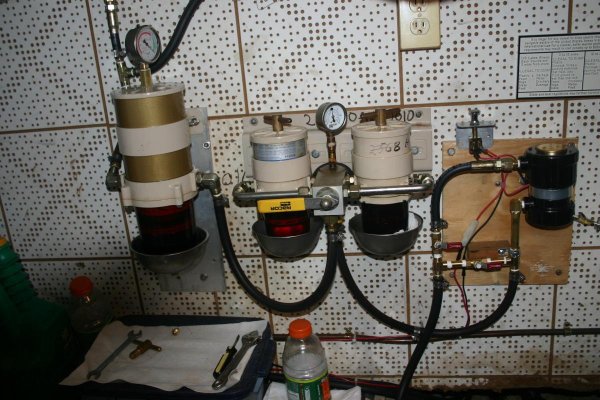I'll elaborate on my theory that progressive filtering is counterproductive.
First; It does a sub-optimum job due to media. To set a baseline, let's suppose you need to design a system that needs to trap to the 2 micron level. You have a HPCR diesel. Per test results, a 2 micron filter is on the order of 98% efficient, first pass. So, you need a second 2 micron filter to follow. Page 96 of:
https://etd.lib.metu.edu.tr/upload/12611586/index.pdf. So, now you have a two filter efficiency of .98 + .98*2 = 99.96%. A 30, then a 10 micron filter in front doesn't help the 2 micron trapping at a significant level.
Second; The idea of a "final filter" on-engine to work with a single off-engine filter is flawed. On engine filters are subject to vibration, especially on diesels. Page 116 of the above doc. This hurts efficiency especially on these single micron sizes. So, you don't get full benefit of a multiple filter pass at small micron sizes. Some of that last 2% is being shook out of that last filter, going into the engine.
Third; You don't know with certainty, what size particulates are in the fuel. The forwarded benefit of progressive filtering is primarily related to spreading the particles out among several filters, thereby prolonging the service life. This may work great with a continuous spread of particle sizes, each being trapped in the various media. It will not usually work that way. One filter will clog before the others, and the question is then: which one?? This then, talks of complexity. Many canisters to vacuum monitor. If you have a 30 and 10 off-engine, plus the back up filters, you are at 4 monitors, and still have not accommodated the on-engine filter. If you go 30,10,2 off engine, paired, then you have significant monitor, plumbing, and operational complexity.
Fourth; Each progressive filter needs to satisfy the flow rates. And, larger is better, not just for service life, but for media efficiency. Filters work better with less pressure and less flow. Water separation too, but lets not expand this argument. But, with progressives, you have a multitude of filters to arrange, and is becomes less likely each will be "very large".
So: the alternative.
First filter: a "very large" 2 micron filter. 98% efficient at 2 micron, actually more, since the specific flow rate per unit media is low. The ability to accommodate more 100 micron particles is greater than the progressive, since I now have room for a larger filter.
Second filter; Another, of the exact same filter.
Engine filter: should need changing now once per millennium. Exaggerated, but you get the idea. It doesn't really have much to do. Plus, it shakes too much to trust for the small stuff anyway.
benefits; Stocking only one type of filter at sea. No guesswork required to figure out which filter is clogged. Plus, no excuse not to monitor that lead filter, its' the one. Better filtering; not relying on the on-engine filter. Water sep will be better with the large filter, that's an argument again related to speed of the fluid at the media, and the size of the system, below the media, to hold the water.



